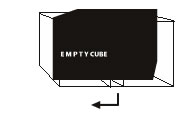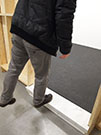GONÇALO BARREIROS
CAPC - Círculo de Artes Plásticas de Coimbra January, 18, 2013

CONTACTS
www.veracortes.com
EXHIBITION INFORMATION
Nº 17
Marble, felt and eletronic device
Two spaces, one step and a warning
The project Gonçalo Barreiros has conceived for EMPTY CUBE emerges from an interest in the relationship between the physical movement of the viewer (with the dynamic and willing outlook of the visitor) and a space with architectural features. Barreiros’ work commonly features actions in space or alterations of it, which often indicate the apparent absence of an explicit exhibitive purpose, and thus relaunch the debate on the taxonomy of the exhibition space and its connections with the public space, by focusing on its enjoyment as the place for the presentation of an artistic object.
The built space, explored and used by the artist as a means to display his work, undergoes a transformation that turns it into a reflective context, within which the author conceives sculptural elements that may emerge as physical or immaterial (sound) objects, which intersect and re-contextualise that same space as a chamber of variable meanings that affect the viewer’s awareness.
His current work, nº 17, created in the gallery of CAPC – Círculo de Artes Plásticas de Coimbra, explores the connections generated by the visitor’s presence in the architectural premises by focusing its intervention on the EMPTY CUBE space, which for one night becomes an invasive space within the gallery. Gonçalo Barreiros changes the Cube’s inner space (the EMPTY CUBE project’s temporary location), by reducing its height, thus changing its rapport with the gallery’s space. At the cube’s entrance a marble step, specifically designed for this event, has been installed, lending a new perspective to the entry via the use of noble and long-lasting material that (ironically?) opposes the ephemerality that is a feature of the project itself.
The action of unlevelling the cube’s floor, combined with a sound signal triggered by the visitor’s body as it passes from the gallery to the interior of the cube, once again brings into play the questioning of the connections between the exhibition space and the exhibition itself as a critical opportunity to rethink their respective operative premises.
This interdependence, based on the space’s shape and conditions (on the recontextualisation of architecture and its limits), has been defined by Daniel Buren in a 1975 essay, from which I quote:
“Every place radically imbues (formally, architecturally, sociologically, politically) with its meaning the object (work/creation) shown there. Art in general refuses to be implied a priori and so pretends to ignore or reject the draconian role imposed by the museum (the gallery), a role both cultural and architectural. To reveal this limit (this role), the object presented and its place of display must dialectically imply one another”1 .
It is also important to consider the title of this project: nº 17. It could possibly be associated to a toponymic reference, the evocation of a place that would find itself re-interpreted via this installation. However, it is simply the (standard) measurement of the marble step that constitutes the material change in the cube’s architecture: a poetic and disruptive way of conveying through writing a context and a place of passage.
Finally, Gonçalo Barreiros’ intervention contains yet another feature, one that invokes commercial facilities and their usual sound-emitting devices (as standardised as the step’s measurement), whose ring warns that someone has came through the door, that boundary-line between places or contexts.
João Silvério
January 2013






